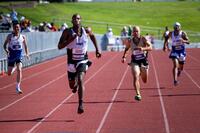Simply put, the Rule of Thirds explains how we typically have three outcomes to our day. We have great days when we feel healthy and highly productive. We have average days when we are doing well, but could be better. And then, we all have the bad days, when life gets hard and interferes with our best-made plans. You should expect these days as a part of life and do your best with any of the outcomes.
Our fitness training is similar.
I first heard the Rule of Thirds when a former athlete, Alexi Pappas, shared her story about preparing for the Rio Olympics in 2016. In her memoir "Bravey: Chasing Dreams, Befriending Pain, and Other Big Ideas," she shares what happened when she learned this Rule of Thirds.
Months before the Olympics, she became irritated and nervous about her running performance. She had yet to meet her Olympic-level run times, ones she'd achieved a few months prior. Her coach, Ian Dobson (also a former Olympian), explained that her performance was not a problem because it aligned with the Rule of Thirds. It works like this:
• A third of the time, you will feel good.
• A third of the time, you will feel OK (not good, but not bad).
• A third of the time, you will perform poorly.
As long as you are within that ratio, you are in the correct zone, especially when training hard and focusing on achieving a goal. However, if you feel bad more than that ratio, it is a sign you are overtraining or under-recovering and need to go light and take a recovery day or two.
Also, an essential factor to realize is that if you are feeling good all the time (outside of the third ratio), you're not working hard enough -- and the worst place to be is in the middle. If you feel just OK more than a third of the time, you may not be mentally and physically as engaged as you should be.
Use this Rule of Thirds as a tool for self-assessment, but consider the following for additional points to gain from the rule:
Embracing Life's Challenges
The Rule of Thirds encourages us to view obstacles as opportunities for growth and breakthroughs. It reminds us to accept average to below-average physical performance and use it as an assessment tool for adjusting to the present to see future progress. These adjustments will help us feel and perform better as well.
Balancing Work and Rest
Striking the right balance between pushing ourselves and giving ourselves a break is a challenge, but if you are more often in the "OK" and the "poor" thirds, it is a good sign that something is off. The key to optimal performance is the mastery of recovery. It is important to understand the essentials of the recovery tools available to us if we are open to them.
Shifting Perspectives on "OK" or "Poor" Days
The Rule of Thirds teaches us to view "OK" and "poor" days as an integral part of the growth process. By embracing this mindset, we can learn to love and appreciate the less-than-optimal days in our daily lives involving work, school, relationships and future goals. By placing them in their proper categories, the "OK/poor" off-days become less powerful, and we avoid the anxiety and overwhelming feelings of failing when we name and tame them.
Even with dedicated training and rigorous recovery practices of eating, sleeping and hydrating well, tough days will still arise, but they may be less frequent. View these "OK" and "poor" days as opportunities to strengthen mentally by resting or pushing harder. This is the most challenging question to answer. Do I rest or push harder?
For many, resting is as difficult as grinding through a workout when not at your best. My advice is to try a 10- to 15-minute warm-up as if you were going to train, and if you do not feel better after the warm-up, pull back on the workout and only do 50% of it. You may feel great after a warm-up and only need a few minutes to return to the training groove. By often pushing through these warm-ups, the remaining workout/training session can be one of your better days, even if it started poorly.
Pushing through with the right mindset and adjusting to training on these tough days will build your inner strength, decrease the anxiety of the process and prepare you for the difficult moments that may arise. So don't be discouraged by the bad days; embrace them and use them as stepping stones toward your goals. You may find that after an easy day or a day of rest, you come back stronger than ever.
Stew Smith is a former Navy SEAL and fitness author certified as a Strength and Conditioning Specialist (CSCS) with the National Strength and Conditioning Association. Visit his Fitness eBook store if you're looking to start a workout program to create a healthy lifestyle. Send your fitness questions to stew@stewsmith.com.
Want to Learn More About Military Life?
Whether you're thinking of joining the military, looking for fitness and basic training tips, or keeping up with military life and benefits, Military.com has you covered. Subscribe to Military.com to have military news, updates and resources delivered directly to your inbox.


















